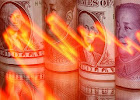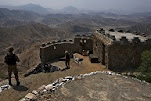United States and its allies across the globe are struggling
to support protesters in Iran in what observers say is a make-or-break moment
that could tip the scales for regime change in Tehran.
US President, Joe Biden said in early November that
“we’re gonna free Iran. They’re gonna free themselves pretty soon.”
But
outside experts say US policy focused on diplomacy with Tehran over its nuclear
program, and the disunity within and outside Iran, puts the favor in the hands
of the nation’s current government.
“The problem is not only the foreign policy decisions of the
US. There’s no united front on the end of the protest movement, there is no
leadership,” said Ceng Sagnic, Chief Analyst of TAM-C Solutions, a
multinational private intelligence company.
Iran’s
leaders have attempted to brutally suppress demonstrators that originally took
to the streets protesting the death of Mahsa Amini, after she died in custody
of the country’s morality police. Amini was detained for allegedly wearing her
headscarf incorrectly.
Since
then, protests have grown to include calls for the downfall of the
country’s Islamic rulers.
At least 14,000 people are reported to have been arrested
and hundreds are believed to have died in the demonstrations, including dozens
of children. The youngest victim is believed to be nine years old.
“The Iranian government and the regime as a whole have the potential
power to suppress the protest movement,” Sagnic said.
US Special Envoy for Iran, Rob Malley reacted to a recent
CNN investigation saying that it documented unspeakable acts of sexual violence
by Iranian officials in detention centers.
“It’s a reminder of what is at stake for the Iranian people
– and of the lengths to which the regime will go in its futile attempt to
silence dissent,” he tweeted.
The US,
European Union and United Kingdom have imposed sanctions on individuals and
entities they have identified as responsible for the violent crackdown on
protesters. They’ve sought to ease restrictions on internet access to aid
protesters who have had their service cut off.
Member-states of the United Nations are looking for ways to
condemn and isolate the Islamic Republic, the ruling government of which came
to power in 1979 following a revolution. Outside Iran, individuals are working
to maintain support for the protesters globally.
The Iranian national soccer team stayed silent when their
national anthem played at the World Cup in Qatar, widely viewed as a sign of
support for the protesters. Solidarity protests in Berlin, Los Angeles and
Washington, DC, last month brought together tens of thousands of the Iranian
diaspora and their supporters.
Shayda Gangi, an Iranian American living in DC, helped
launch an exhibit in Georgetown displaying protest art created over the past
two months in an effort to keep attention on the struggle of the people of
Iran.
“All these articles being written, all the people who come
to these exhibits, and showcase this work, is so important and it’s doing what
it’s supposed to do, which is to raise awareness and keep the spotlight on
Iran,” she told The Hill.
The
exhibit, which ran for three days, featured more than 100 pieces from artists
all over the world, including Iranians living abroad, Italian and Israeli
artists, and at least one artist from inside Iran, who sent her work with great
secrecy, quickly deleting communication and even blocking the organizers at one
point as a security precaution, Gangi said.
“I tried to put myself in her shoes and think, ‘would I do
the same thing?’” Gangi said. “And I don’t know. She was scared and is in Iran,
and it’s dangerous, but even with all of that, she was so happy to contribute
to this event, and to do what she could do and to send her artwork to be
shown.”
Sherry Hakimi, an Iranian American activist and founder and
executive director of a nonprofit focused on gender equality, was one of five
Iranian women invited to meet with Secretary of State Antony Blinken and other
top State Department officials in October to offer their advice on how the US
could best support protesters.
“I appreciate that senior US leaders have been listening to
the calls made by Iranians and Iranian Americans alike,” she told The Hill, but
said governments need to be more innovative in how they think about aiding the
protesters.
“These
are unprecedented times – this is the first female-led revolution – so meeting
the moment requires unprecedented measures.”
Hakimi said that on top of sanctions and efforts to hold the
Islamic Republic accountable at the United Nations, countries should focus on
providing health care assistance because injured protesters risk arrest if they
seek care at a hospital.
“I want to see more health care-focused aid being sent to
Iran, whether that’s through the Red Cross, Doctors Without Borders, or some
other organization or mechanism.
There are parts of Iran where people are no longer able to
seek treatment, because the regime has made it impossible — either hospitals
won’t treat them or if they do go to a hospital they can risk arrest, which
makes things worse,” she said.
“To me, that seems like one of the most basic things.”
Human rights groups and news reports have documented
accounts from protesters that they are avoiding hospitals for fear of
arrest from security forces, and that the Iranian government is using
ambulances to infiltrate protests and detain demonstrators.
The danger for protesters seeking medical help was echoed by
Cameron Khansarinia, Policy Director for the nonprofit and nonpartisan National
Union for Democracy in Iran (NUFDI), which also helped sponsor the art exhibit
in Georgetown.
“Protesting in Iran is not like protesting in any other
country,” he said, referencing the extreme tactics of targeting protesters, the
use of live ammunition, detentions, allegations of torture and
killings.
NUFDI
is advocating for the US and other governments to explore setting up a “strike
fund” to distribute the Islamic Republic’s frozen assets abroad among
protesters who have their livelihoods threatened by the government.
“So
providing, at least, a small modicum of financial support to allow these
workers to go on strike and allow their families to have bread at the end of
the day … are very tangible means by which a foreign government could empower
the Iranian people,” he said, calling for governments to devise a “mechanism”
to deliver such cash.
Khansarinia, like others interviewed for this article,
described the protests as unprecedented for their massive scale in the face of
extreme violence by security authorities.
The
Norway-based Iran Human Rights organization has documented at least 416 people
killed, and that includes 51 children. The rights group is also pointing to the
government systematically and disproportionately targeting minorities in Iran,
in particular in the Baluch and Kurdish ethnic regions.
The tactic is aimed at seeking to delegitimize the protests
as an ethnic, separatist movement, private intelligence analyst Sagnic
said.
“By
increasing the oppression in the Kurdish areas, violent tactics, striking
Kurdish Peshmerga bases in Iraq, trying to make it more an ethnic issue,
something that separates Kurdish groups from the rest of Iran, which is a
successful tactic, to be honest,” he said.
Gangi, who helped organize the Georgetown art exhibit, said
that she feels this moment is different because of the scale of support from
the international community.
“This is by far, in my personal experience following these
things throughout the years, this is the first time I’ve seen this much support
from not just the Iranian community and not just within Iran, but the global
community,” she said.
“With what they’re doing within Iran, with the internet
shutdowns, and all the violence — what we’re seeing outside is a small
percentage of what’s happening there. I would really just ask everyone to
continue to do what they’re doing, and keep the light on, on Iran.”




















